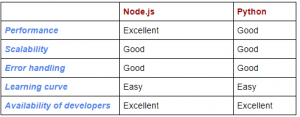Selection of the programming language for a project is one of the primary issues each project should resolve before starting. For backend development, Python and Node.js are often the first languages that come to mind. While Python is a programming language, Node.js is an environment allowing JavaScript code to run on the server side versus in a browser. Node was sort of a quantum leap, as it was the first environment allowing the use of JavaScript both on the client and server sides respectively. Without Node.js, frontend and backend used different languages, which caused certain compatibility issues.
If you’re an app developer considering your next project, you might be wondering which tool to choose.
The primary requirement from a programming tool is performance. This defines the speed of your application response and directly affects how fast your code is executed. Node is significantly faster being based on Chrome’s V8 which is a powerful engine, making it a much better choice for real-time applications, for example, those involving chat functionality.
What could this mean in practical terms for you?
Written in Javascript, the dominant language of the front-end development along with the same language at the back end means you only need a smaller and more efficient team. Python has a concise and expressive syntax. It thinks more clearly when writing programs and makes it easier for others to maintain and enhance applications. Also, being dynamically typed and flexible, Python allows writing a code that is less verbose but more modular and extensible.
The rich standard/native library for server-side development is one of the main strengths of Python in comparison to Node.js. The standard library that comes with Javascript is relatively minimal. Node.js needs to use Node package manager (npm), which leads to the extra work of selecting and checking the installed modules and packages. Another important aspect which needs to be taken into account in planning backend development is scalability to serve the increasing number of requests with no compromise in performance. This ability is essential in content-heavy applications as well as in those serving multiple new users.
Node.js creates a single-thread asynchronous architecture with I/O operations completed outside the thread and not blocking it. This guarantees smooth scalability within simple web apps, however, development of complex applications with many concurrent processes requires in-depth knowledge, attention and careful engineering research. Python, in turn, does not support asynchronous programming by default, but it supports co-routines with which asynchronous processing can be easily achieved.
Easiness and transparency of error handling for Python & Node.js
This can also be a critical issue. Both languages deal well with throwing and catching exceptions, errors occurring during code execution. Though, the general notion is that handling exceptions in Python is easier and takes less time to debug and fix errors.

The choice of technology for a project depends on numerous factors including application type, industry sector, performance requirements, developers experience etc. Project managers must consider the speed of development, the need for scalability, and application’s type. For fast development of CPU-heavy applications or the development of IoT back-end, go for Python. Conversely, choose Node.js for SPAs and other I/O heavy solutions. However, if you know neither of them, learning Python may be easier for its cleaner syntax and more compact code. Python requires fewer lines of code than Node.js to reach the same result. Make a smart choice for the solid foundation of your applications.





